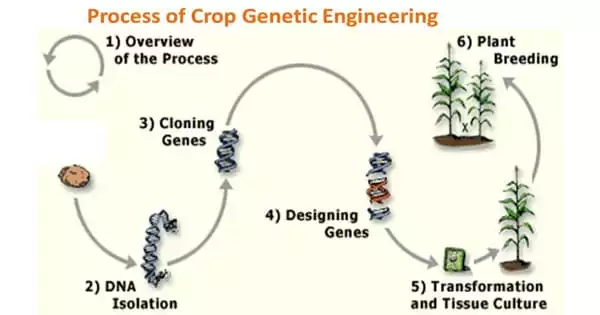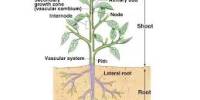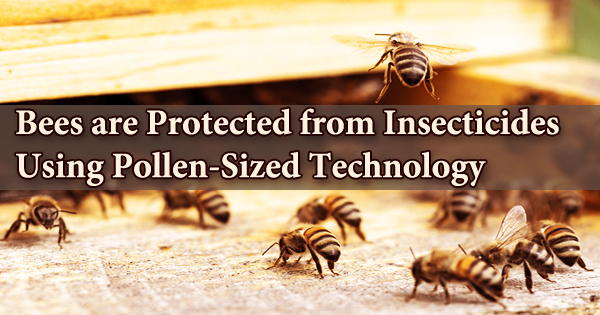Genetic modification, often known as genetic engineering, refers to methods for changing the pattern of genetic material. That genetic information, located inside cells in molecules called DNA, provides the “blueprint” for any living thing, whether plant, animal, or the smallest microbe. Changing the pattern of the DNA molecules may allow for the modification of a plethora of properties in a living organism.
GM is a method that includes introducing DNA into the genome of an organism. To create a GM plant, new DNA is inserted into plant cells. Typically, the cells are then cultivated in tissue culture, where they mature into plants. These plants’ seeds will carry the modified DNA.
Researchers have devised a method to boost crop quality without the use of genetically modified plants. The new technology is based on a spray that transfers bioactive molecules into plant cells via their leaves and might be used to help crops resist pests or become drought resistant in less time and at a lower cost than genetically modifying crops.
We can now directly edit genomes and generate genetically modified organisms (GMOs), including GM food, thanks to advances in technology. Making transgenic plants, on the other hand, takes time and money, and it has yet to acquire significant public favor
Masaki Odahara
Researchers from Japan’s RIKEN Center for Sustainable Resource Science (CSRS) have devised a method to improve crop quality without the use of genetically modified plants. Rather of altering plant genomes, the new method employs a spray that transfers bioactive chemicals into plant cells via their leaves. The new approach might be used to help crops resist pests or become drought resistant in less time and at a lower cost than developing genetically modified crop lines. The findings were published in the scientific journal ACS Nano.
We can now directly edit genomes and generate genetically modified organisms (GMOs), including GM food, thanks to advances in technology. Making transgenic plants, on the other hand, takes time and money, and it has yet to acquire significant public favor. Researchers at RIKEN CSRS, led by Masaki Odahara, have created an alternative to GM food that can address these issues. Instead than altering a plant’s DNA to prevent it from expressing a specific gene, the same gene can be silenced on the fly by injecting a specific bioactive molecule into the plant. In this case, a carrier capable of penetrating plant cell walls transports the bioactive ingredient into the plant’s cells.
While the concept was simple, making it a reality was difficult. “We had to consider a delivery mechanism that would be practical for farmed crops under real agricultural conditions,” adds Odahara, “in addition to inventing a way to introduce bioactive molecules into the plants.” The researchers found that the ideal technique would be to use a spray that could be easily distributed across broad fields.

Many different forms of nanoparticles can enter plant cells. Cell-penetrating peptides (CPPs) were chosen by the researchers because they may target specific structures within plant cells, such as chloroplasts. The first challenge was determining which CPPs work best when sprayed. They labeled natural and synthesized CPPs with fluorescent yellow, sprayed them on plant leaves, and quantified the amount of fluorescence in the leaves at various time periods using a confocal laser-scanning microscope. They discovered numerous natural CPPs that could penetrate into the outer layer of the leaves, and in some cases deeper, after completing this method in conventional laboratory Arabidopsis thaliana, as well as several varieties of soybeans and tomatoes.
Further investigations revealed that when plasmid DNA was linked to the CPPs, the approach worked well, and analysis revealed that genes were successfully expressed in the leaves of both A. thaliana and soybeans after being delivered into the cells via an aqueous spray. The researchers also discovered that by incorporating other proteins and nanostructures into the spray solution, they were able to temporarily increase the number of pores in the leaves, increasing the amount of spray taken up by the plant.
Crop yield may frequently be increased by inserting or removing genes. After developing a transgenic plant that overexpresses yellow fluorescence in the leaves, the researchers linked RNA that inhibits fluorescent protein expression to a CPP. Spraying the leaves with this compound silenced yellow florescence expression worked as expected. “This conclusion was significant,” Odahara says, “since any alternative to genetic alteration must be able to accomplish the same functional goal.” Finally, by attaching a chloroplast-targeting peptide to a particular CPP-RNA complex, the researchers were able to silence genes specific to chloroplasts.
“Mitochondria and chloroplasts regulate a large portion of a plant’s metabolic activities,” Odahara explains. “Using bioactive chemicals given by spray to target these structures could significantly improve commercially desired quality attributes in crops. The next phase is to improve the delivery system’s efficiency. Finally, we anticipate that this approach can be utilized to safeguard crops from parasites and other potentially detrimental elements.”
















